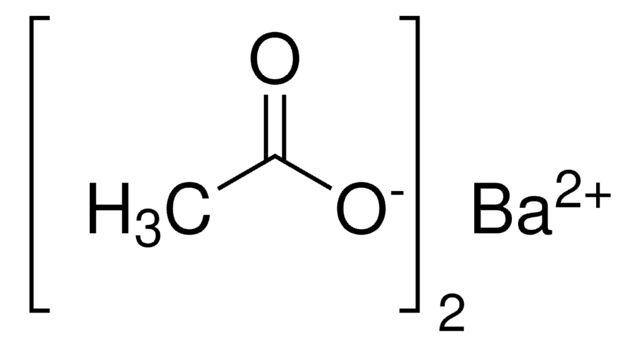244112
Titanium(IV) butoxide
reagent grade, 97%
Synonym(s):
Orthotitanic acid tetrabutylester, TNBT, TYZOR® TBT organic titanate, Tetrabutyl orthotitanate, Tetrabutyl titanate
About This Item
Recommended Products
grade
reagent grade
Quality Level
Assay
97%
form
liquid (or viscous liquid)
liquid
reaction suitability
core: titanium
reagent type: catalyst
refractive index
n20/D 1.491 (lit.)
bp
206 °C/10 mmHg (lit.)
density
1.00 g/mL at 20 °C (lit.)
SMILES string
CCCCO[Ti](OCCCC)(OCCCC)OCCCC
InChI
1S/4C4H9O.Ti/c4*1-2-3-4-5;/h4*2-4H2,1H3;/q4*-1;+4
Looking for similar products? Visit Product Comparison Guide
Application
Legal Information
Signal Word
Danger
Hazard Statements
Precautionary Statements
Hazard Classifications
Eye Dam. 1 - Flam. Liq. 3 - Skin Irrit. 2 - STOT SE 3
Target Organs
Central nervous system, Respiratory system
Storage Class Code
3 - Flammable liquids
WGK
WGK 1
Flash Point(F)
107.6 °F - Pensky-Martens closed cup
Flash Point(C)
42 °C - Pensky-Martens closed cup
Personal Protective Equipment
Choose from one of the most recent versions:
Already Own This Product?
Find documentation for the products that you have recently purchased in the Document Library.
Customers Also Viewed
Articles
Mesoporous Oxides and Their Applications to Hydrogen Storage
Titanium dioxide (TiO2) is an important n-type semiconducting material that shows interesting characteristics such as photoswitchable surface wettability, high photocatalytic activity, bistable electrical resistance states and high electron drift mobility.
In this paper, we discuss recent advances in the preparation of various TiO2 porous structures via hard and soft-templating routes. Specifically, we focus on recent developments in TiO2 mesoporous thin films in a combined sol-gel and evaporation-induced self-assembly (EISA) process.
Thermoelectric Performance of Perovskite-type Oxide Materials
Protocols
Monodisperse, surfactant-free polymer spheres for use as colloidal crystal templates can be easily obtained in reasonably large quantities. Typical synthesis methods for poly(methyl methacrylate) (PMMA) and poly(styrene) (PS) by emulsifier free emulsion polymerization are described below and yield spheres several hundred nanometers in diameter.
Our team of scientists has experience in all areas of research including Life Science, Material Science, Chemical Synthesis, Chromatography, Analytical and many others.
Contact Technical Service



